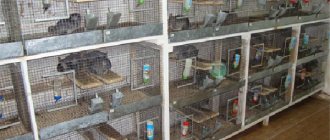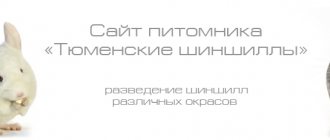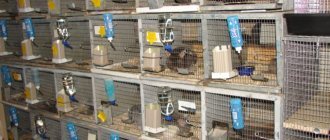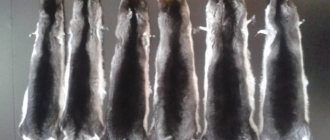Raising fur-bearing animals involves the production of fur, which is highly valued on the market. Among the popular areas of animal husbandry, one can highlight chinchilla breeding as a business.
The fur of this animal is superior in quality to mink and sable. High demand for chinchilla products, as well as low competition, allow an entrepreneur to earn good income even from a small farm.
In rural areas, you can still breed nutria.
Who are chinchillas?
Chinchillas are large rodents with valuable fur that naturally live in South America in high desert areas. They have large round ears, black eyes and long mustaches. The animals are nocturnal and feed on grass and insects.
As a result of mass catching, the chinchilla population has declined catastrophically, and they are listed in the Red Book. Long-tailed chinchillas, about half a meter long (including the tail), are bred under artificial conditions.
Chinchilla fur is usually gray-blue in color, very thick and dense. It protects the animals’ bodies from hypothermia at an altitude of 4-5 km above sea level, and is not afraid of any parasites. Chinchillas do not sweat or smell; to clean their fur, they bathe in sand and dust.
Life expectancy in captivity is up to 20 years. Adults weigh 600–800 grams, newborn cubs weigh 30–70 grams. Young females give birth to 1-2 cubs; with age, the litter increases to 5-6 babies.
The name Chinchilla comes from the Peruvian province of Chincha.
Purchase and selection of breeding stock
High-quality chinchilla breeding stock is a key factor in successful chinchilla breeding. Such animals, especially males, are expensive, but they invariably pay for themselves, as they retain their reproductive functions for 15-18 years.
To understand how important it is to acquire good breeding material, let's look at history. In 1954, the first chinchilla fur auction was held in New York, which shocked key players in the industry. More than half of the skins were not in demand due to poor quality and non-standard fur color. As a result, the market collapsed, prices fell sharply, and in Canada alone, about 4.5 thousand farms declared themselves bankrupt. But at that time, just one pair of chinchillas cost fabulous money, from 3 to 5 thousand dollars.
It is impossible to describe all the characteristics of choosing purebred animals in this article. Firstly, there are about 12 mutations of the standard chinchilla color alone. Plus, 10 combinative forms are added to them. But the best and most popular of them are the standard color and the so-called “black corduroy”.
In order not to make a mistake when choosing chinchillas for your breeding, it is better to contact breeders who keep at least 500-600 breeding stock. It is in such farms that systematic work is carried out to improve the gene pool of animals.
Industrial value
Chinchillas have been bred for fur, meat and offspring since the beginning of the 20th century, when Americans, with the permission of the Chilean government, took several specimens to California and adapted them to life in different climatic conditions.
Fur products are very expensive due to the unique characteristics and small size of the skins - about a hundred pieces are required to make one fur coat. The cost of chinchilla clothing is tens of thousands of dollars. In Europe, the chinchilla business is already well developed and almost all production is carried out for sale at the Copenhagen Fur Auction.
Chinchilla meat is used as a dietary food for tuberculosis, sclerosis and cancer. It is readily purchased by restaurants specializing in exotic cuisine.
Chinchillas are kept as pets in the same way as hamsters or guinea pigs. They are unpretentious, very pleasant to the touch, and have a pronounced character.
You can start a chinchilla breeding business with a few individuals and gradually increase the volume. The animals do not require special care, do not take up much space, do not scream or stink, so it is quite possible to create a mini-farm at home.
You can download a free chinchilla breeding business plan here.
Market analysis
The domestic sales market is a fertile niche for chinchilla farm owners. The business has become widespread in Europe and is thriving despite the competition. In our country the niche is still free. If you manage to get high quality fur, there will be no problems with its sale. One skin is valued more expensive than sable or mink.
The following business concepts deserve attention:
- raising elite breeds of animals. To do this, you do not need to have a large livestock - it is enough to purchase 10 -15 individuals and start breeding them;
- sale for meat - sales through restaurants will provide high income;
- fur trade - this requires 200-300 individuals. Most likely you will need an employee. Don’t skimp on your chinchillas’ food; provide the animals with a place to swim and play—this way the fur will be of better quality.
Breeding technology
In nature, chinchillas feel normal at temperatures up to +40°C, but for comfortable keeping in captivity you need to create the following conditions for them:
- humidity about 50%;
- temperature from +18°С to +20°С;
- room lighting at the rate of 60 W per 10 sq. m.;
- lack of direct sunlight;
- absence of drafts;
- clean water for drinking;
- sand bath for bathing;
- daily cleaning;
- weekly change of bedding in the cage;
- monthly sand change;
- disinfection of the premises once every 6 months.
On an area of 1 sq. m. can accommodate up to 3 individuals. Usually there is 1 male for 1 female, but it is also possible to form a family of 1 male and several females. Chinchillas begin to reproduce at the age of 7 months; they produce 2-3 litters per year, 1-2 cubs in each.
For example, a population of 2 males and 10 females can increase to 70 individuals after 12 months. The gender split is approximately equal. All the healthiest and most beautiful females remain on the farm for breeding. The best specimens are also selected from males, but in much smaller quantities. The remaining animals are sold to pet stores. With age, the litter of females increases to 5-6 individuals, and the herd grows faster.
Thus, in a couple of years, the animals will multiply to 300-350 individuals, and then you can start selling fur and meat.
Timeframe for implementation of the idea
You can choose any time of year to set up a furry animal farm. There is no need to rely on seasonality. If the sales issue is resolved, you can determine the number of chinchillas and cages. The room is fully equipped to accommodate the wards, so we begin the search for cages and animals. Making your own cells may take longer.
The premises must be disinfected before residents move in. The appropriate permission and a certificate of processing were received from the veterinarian, and a schedule of activities was drawn up.
When registering an activity, everyone decides for themselves:
- Register before purchasing chinchillas.
- First, establish the process and, having received a certain result, begin legalization.
We will draw up a schedule of necessary works and deadlines for their implementation:
| Type of work/Date of completion | 08.17 | 09.17 | 10.17 | 11.17 | 03.18 |
| Writing a business plan, searching for premises. | + | ||||
| Search for sales channels. | + | + | + | + | |
| Registration of activities. | + | ||||
| Analysis of breeders of furry animals, filling out an application. | + | ||||
| Preparation of the territory, purchase/manufacture of cages, installation of ventilation, alarm systems in the building. | + | + | |||
| Analysis of chinchilla food suppliers, filling out an application. | + | + | |||
| Creation of a business card website, a group on social networks. | + | + | |||
| Carrying out veterinary work on the farm, placing animals in cages. | + | ||||
| Beginning of animal care, first mating. | + | + | + | ||
| First offspring | + |
Under normal housing conditions and the pair quickly getting used to each other, the female lambs 4 months after mating. From this moment, you can calculate the possible profit and sort the wards for sale or increase the number of your farm.
Equipment
Chinchillas are kept indoors in iron mesh cages 40-45 cm high. On the front wall there is a door, feeders and drinkers. A shelf for resting is attached to the back in the middle; the bottom is lined with pine sawdust. The cages are placed one on top of the other in several tiers and several rows in such a way that animals raised for different purposes are located separately:
- For fur, meat or tribe.
- Increase in livestock.
In addition to cells, you also need to purchase:
- feeders;
- drinking bowls;
- baths for bathing;
- pallets for sawdust;
- heater;
- air conditioner.
All equipment that comes into contact with chinchillas should not be made of wood, since these animals are rodents with very sharp front incisors. The exception is the breeding period, when a box for the young is placed in the cage.
Acquisition
The most important part of the business plan is the acquisition of the first animals. For a novice entrepreneur, it will be enough to purchase 10 females and 2 males. This will save costs on starting the project and will allow you to understand the nuances of chinchilla breeding without significant risk.
Healthy purebred specimens of popular coloring cost 6,000 rubles. – 9,000 rub. There are a dozen basic colors of chinchillas:
- White Wilson - very light fur all over the skin and black eyes.
- White velvet - the gray muzzle and paws stand out against a white background.
- White-pink is a slightly darker color than Wilson's White, with pink eyes.
- Beige - has several varieties, from dark to light, with pale eyes.
- Sapphire - light fur with a soft blue tint. This coloration is very difficult to obtain, and the animals subsequently require increased care.
- Purple is the main color closer to gray, with a slight tint.
- The standard color is the natural appearance of chinchillas: dark ash back and light belly.
- Black velvet (corduroy) - black top with a smooth transition to a light bottom, beige nose and black eyes.
- Ebony - varies from dark gray to completely black.
In addition, there are various shades obtained by combining basic ones or as a result of mutations. The most popular are chinchillas with standard coloring or black and velvet.
When choosing adult animals (7-8 months old), you need to pay attention to the following points:
- correct rounded head shape;
- short rounded ears;
- there is practically no neck;
- smooth back without visible thickenings;
- dense and elastic fur, thick over the entire surface of the body;
- weight approximately 600 grams;
- healthy, beautiful producers.
It is best to purchase chinchillas from farms that have been breeding animals for a long time. In a serious farm, management will provide a veterinary certificate and advise on maintenance and care.
Chinchillas naturally have strong immunity and do not need to be vaccinated.
Possible risks
Any business has its downsides and pitfalls. Chinchilla is no exception.
Let's consider the main risks that may arise on the path to success:
- Diseases. Although the risk of disease in the entire livestock is relatively small (chinchillas have strong immunity), there is always a danger of an epidemic due to errors in care and feeding.
- Poor quality young stock. There are many offers on the market for the sale of fluffy animals. Their prices range from $50 and up. And here lies the catch: it’s quite difficult to find quality specimens in Russia. And little-known farms offer animals that, despite their poor pedigree, are strongly reminiscent of breeding animals in appearance.
- Selection of feed. Nutrient mixtures offered by domestic manufacturers are not always of high quality: rabbit food is often sold under the guise of chinchilla food. Therefore, you will have to either supplement it with additives yourself, or buy expensive imported ones.
- Implementation. If you have not thought through in advance where you will sell the offspring, then problems with sales will arise immediately after the appearance of the first offspring.
Nutrition
Chinchillas are fed once a day in the evening, as they are nocturnal. The basis of the diet is balanced granulated food. Additionally, herbs are introduced - fresh and dried, apples, carrots. To maintain immunity and compensate for the lack of fresh air, it is necessary to give vitamin complexes weekly.
An adult animal eats about 50 g of food per day. However, it is necessary to take into account the rather large difference in the weight of animals depending on gender, species and age. Therefore, it is necessary to adjust the dosage for specific individuals.
Particular attention should be paid to the nutrition of pregnant females and young animals. For the first one and a half to two months, the cubs are fed with milk, then they are removed from the mother into a separate cage and given regular food. It is extremely undesirable to change anything in the diet of females and young individuals, as they react sharply to new foods.
Mini-farm registration
At the initial stage, there is no need to officially register a chinchilla business, since it will take about six months to raise the first litter, from which several individuals can be sold.
Before implementation, you need to choose one of the registration options:
- Individual entrepreneur. Suitable for a single business owner.
- Farming. Relatives can participate in the enterprise, but for this it is necessary to draw up an agreement.
To pay taxes, it is most profitable to choose a single agricultural tax at a rate of 6% of profit.
No license or other permits are required to raise chinchillas. It is necessary to register with the veterinary service.
Personnel issue
The ease of breeding chinchillas is noted in the fact that the animals do not require the involvement of a large number of people in their care. One entrepreneur can handle all the responsibilities.
During the day, feeding, cleaning, and analysis of the general condition of the wards are carried out. At night there is video surveillance and the house is guarded.
The breeder must pay taxes and make required contributions after officially registering the activity.
A veterinarian is not registered as a staff member. It is necessary to conclude an agreement for the provision of services and invite a specialist as the services specified in the schedule are carried out.
Sales organization
The mini-farm begins to receive income from the very first offspring of purchased breeding animals. Individuals that are unsuitable for breeding or have poor quality fur are sold through pet stores or markets to be kept as pets.
Animals that meet all standards remain on the farm for breeding or are sold to other farms. The cost of breeding chinchillas is much higher than culled ones.
To sell chinchillas for fur, you need to have 400-500 individuals in stock. The skins are harvested mainly from male animals. Consumers are fur factories and studios in large cities. The cost of high-quality skins can reach 10,000 rubles.
Chinchilla meat is purchased by restaurants as an exotic and dietary product.
With high production volumes, it is advisable to open your own workshop for sewing fur products.
Until there are enough positive reviews about the farm, you can promote your chinchilla business using conventional advertising means:
- advertise in the press and on the Internet;
- place business cards and brochures in pet stores in the city;
- join a specialized online community, invite those interested on excursions;
- create a website;
- take part in zoo exhibitions.
Financial calculations
To start a chinchilla farm and determine whether running a business at home is profitable or not, you need to plan initial and subsequent costs. The cost of renting the premises is excluded from the calculation; only minor repairs will be required. Calculations are made for keeping chinchillas on an industrial scale - per 100 individuals.
Start-up capital:
| № | expenditures | Amount, rub. |
| 1 | Indoor renovation | 10 000 |
| 2 | Purchase of equipment and consumables | 220 000 |
| 3 | Purchasing breeding specimens at wholesale prices | 300 000 |
| 4 | Purchase of food and supplements for 1 month | 10 000 |
| 5 | Business registration | 1 000 |
| 6 | 10 000 | |
| 7 | Other | 20 000 |
| Total | 571 000 | |
Fixed monthly costs for maintaining animals are:
| № | expenditures | Amount, rub. |
| 1 | Utility bills (mainly electricity) | 8 000 |
| 2 | Purchase of feed and additives | 10 000 |
| 3 | Veterinarian services | 20 000 |
| 4 | Tax payments | 6 000 |
| 5 | Additional expenses | 10 000 |
| Total | 54 000 | |
Breeding chinchillas as a business at home, judging by reviews, brings up to 500% profit. Despite the fact that the most valuable thing in animals is fur, the main income comes from the sale of live animals for personal use or breeding.
The annual revenue of a mini-farm can be calculated based on the expected sale of 300 bred individuals:
| № | Type of income | Qty | price, rub. | Amount, rub. |
| 1 | Breeding chinchillas | 100 | 9 000 | 900 000 |
| 2 | Culled chinchillas | 100 | 3 000 | 300 000 |
| 3 | Chinchillas for fur | 100 | 6 000 | 600 000 |
| Total | 1 800 000 | |||
Profit for the first year of operation will be: RUB 1,800,000. — 54,000 rub. x 12 months — 571,000 rub. = 581,000 rub. In the future - 1,152,000 rubles.
With good care, chinchillas retain the ability to reproduce for up to 15 years. Therefore, this type of business is one of the most stable, long-term and profitable.
Video: chinchilla breeding as a business – profitable or not?
Reviews from experienced entrepreneurs
Daria, Pskov region
My parents are breeding chinchillas. They started with a small number of individuals, but then they realized that these animals are very profitable, now they have more than 100 heads. The farm is located right on the plot in a special extension. To maintain the heat at least 18 degrees, a heater was installed; it doesn’t turn on that much. Once they forgot to turn it on, 6 chinchillas died. Animals are not fussy about caring for them, but they need to be fed and watered every day and cleaned regularly. The animals eat little and take up minimal space. Parents sell chinchillas to pet stores and sell them online as pets, since they are not involved in skinning.
Fedor, Saratov
When I decided to start farming, I was looking for a business in which I didn’t need to invest a lot right away. Among my friends who breed animals, there is a chinchilla specialist, he explained everything, and it turned out that chinchillas are what I need. I don’t slaughter them for fur; I mainly sell breeding specimens to beginning farmers in Russia and neighboring countries, and sell the rest to a pet store. I am glad that I chose such a profitable path in farming.











